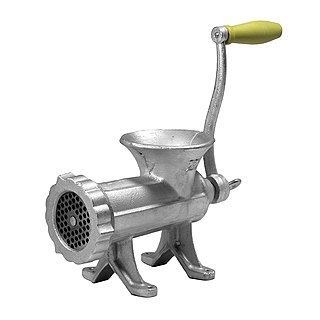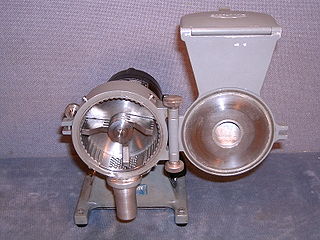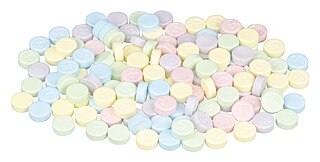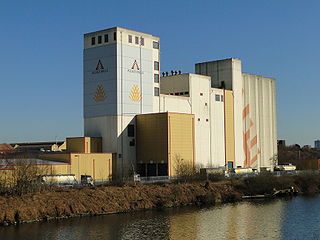A grinder-mixer is a type of agricultural machine used to process livestock feed from grain. A grinder-mixer is a portable mill that combines the mixing and grinding operations.
Grinding of ingredients generally improves feed digestibility, acceptability, mixing properties and pelletability.
Grain is typically pulverized in a grinder-mixer either by hammer mills or roller mills.
Hammermills are impact grinders with swinging or stationary steel bars forcing ingredients against a circular screen or solid serrated section designated as a striking plate. Material is held in the grinding chamber until it is reduced to the size of the openings in the screen. The number of hammers on a rotating shaft, their size, arrangement, sharpness, the speed of rotation, wear patterns, and clearance at the tip relative to the screen or striking plate are important variables in grinding capacity and the appearance of ground feed. [1]
A combination of cutting, attrition, and crushing occurs in roller mills. These are smooth or corrugated rolls rotating at the same speed set at a pre-determined distance apart with material passing between the two. A tearing action may be added by operating the rolls at different speeds and by different for each roll. [2]
The objective of feed mixing is to start with a certain assortment of ingredients called a "formula", totaling some definite weight. This is processed so that each small unit of the whole, either a mouthful or a day's feeding, is the same proportion as the original formula. The mixing process is done in the vertical tank. It determines the balanced nutritional quality of the feed. [3]
After the feed is ground and mixed, it passes through a system of particulate screens. From there, only suitable granules pass on to the delivery process, and waste is sent to the charging chute.

A pestle and mortar is a set of two simple tools used to prepare ingredients or substances by crushing and grinding them into a fine paste or powder in the kitchen, laboratory, and pharmacy. The mortar is characteristically a bowl, typically made of hard wood, metal, ceramic, or hard stone such as granite. The pestle is a blunt, club-shaped object. The substance to be ground, which may be wet or dry, is placed in the mortar where the pestle is pounded, pressed, or rotated into the substance until the desired texture is achieved.

A meat grinder is a kitchen appliance for mincing and/or mixing of raw or cooked meat, fish, vegetables or similar food. It replaces tools like the mincing knife. The food to be minced is placed into a funnel, which sits on top of the grinder. From there, the material enters a horizontal screw conveyor; the screw conveyor may be hand-cranked or powered by an electric motor. The screw squashes and mixes the food. At the end of the screw, the food is passed through a fixed plate, where it exits the machine. The fineness of the minced food depends on the size of the holes in the plate.

A ball mill is a type of grinder used to grind or blend materials for use in mineral dressing processes, paints, pyrotechnics, ceramics, and selective laser sintering. It works on the principle of impact and attrition: size reduction is done by impact as the balls drop from near the top of the shell.

A mill is a device, often a structure, machine or kitchen appliance, that breaks solid materials into smaller pieces by grinding, crushing, or cutting. Such comminution is an important unit operation in many processes. There are many different types of mills and many types of materials processed in them. Historically mills were powered by hand or by animals, working animal, wind (windmill) or water (watermill). In modern era, they are usually powered by electricity.

A burr mill, or burr grinder, is a mill used to grind hard, small food products between two revolving abrasive surfaces separated by a distance usually set by the user. When the two surfaces are set far apart, the resulting ground material is coarser, and when the two surfaces are set closer together, the resulting ground material is finer and smaller. Often, the device includes a revolving screw that pushes the food through. It may be powered electrically or manually.

A hammer mill is a mill whose purpose is to shred or crush aggregate material into smaller pieces by the repeated blows of small hammers. These machines have numerous industrial applications, including:

A wet grinder can refer either to a tool for abrasive cutting of hard materials or to a food preparation appliance used especially in Indian cuisine for grinding food grains to produce a paste or batter. A wet grinder for abrasive cutting uses fluid for lubrication or cooling; for food preparation, a wet grinder combines water to grain as it is ground to produce a batter.
A pulverizer or grinder is a mechanical device for the grinding of many different types of materials. For example, a pulverizer mill is used to pulverize coal for combustion in the steam-generating furnaces of coal power plants.

A raw mill is the equipment used to grind raw materials into "rawmix" during the manufacture of cement. Rawmix is then fed to a cement kiln, which transforms it into clinker, which is then ground to make cement in the cement mill. The raw milling stage of the process effectively defines the chemistry of the finished cement, and has a large effect upon the efficiency of the whole manufacturing process.

Animal feed is food given to domestic animals, especially livestock, in the course of animal husbandry. There are two basic types: fodder and forage. Used alone, the word feed more often refers to fodder. Animal feed is an important input to animal agriculture, and is frequently the main cost of the raising or keeping of animals. Farms typically try to reduce cost for this food, by growing their own, grazing animals, or supplementing expensive feeds with substitutes, such as food waste like spent grain from beer brewing.

Grinding is a type of abrasive machining process which uses a grinding wheel as cutting tool.

Roller mills are mills that use cylindrical rollers, either in opposing pairs or against flat plates, to crush or grind various materials, such as grain, ore, gravel, plastic, and others. Roller grain mills are an alternative to traditional millstone arrangements in gristmills. Roller mills for rock complement other types of mills, such as ball mills and hammermills, in such industries as the mining and processing of ore and construction aggregate; cement milling; and recycling.

A blade grinder, also known as propeller grinder, is a machine that chops material while mixing it, by means of a high-speed spinning blade. Applications of blade grinders for preparing foods include numerous electric kitchen appliances such as blenders, food processors, some garbage disposals, and some coffee grinders. The terms "blade grinder" and "propeller grinder" are in popular use to distinguish the blade grinder type of coffee grinder from other types. Other consumer applications include rotary lawn mowers.
Maize miller is the processing of maize (corn) for safe and palatable consumption as food. Processing can be by machine-milling in either large- or small-scale mills, or by hand-milling in domestic or community settings.

Tableting is a method of pressing medicine or candy into tablets. Confectionery manufacture shares many similarities with pharmaceutical production.

A gristmill grinds cereal grain into flour and middlings. The term can refer to either the grinding mechanism or the building that holds it. Grist is grain that has been separated from its chaff in preparation for grinding.

Feed manufacturing refers to the process of producing animal feed from raw agricultural products. Fodder produced by manufacturing is formulated to meet specific animal nutrition requirements for different species of animals at different life stages. According to the American Feed Industry Association (AFIA), there are four basic steps:
- Receive raw ingredients: Feed mills receive raw ingredients from suppliers. Upon arrival, the ingredients are weighed, tested and analyzed for various nutrients and to ensure their quality and safety.
- Create a formula: Nutritionists work side by side with scientists to formulate nutritionally sound and balanced diets for livestock, poultry, aquaculture and pets. This is a complex process, as every species has different nutritional requirements.
- Mix ingredients: Once the formula is determined, the mill mixes the ingredients to create a finished product.
- Package and label: Manufacturers determine the best way to ship the product. If it is prepared for retail, it will be "bagged and tagged," or placed into a bag with a label that includes the product's purpose, ingredients and instructions. If the product is prepared for commercial use, it will be shipped in bulk.
Dry milling of grain is mainly utilized to manufacture feedstock into consumer and industrial based products. This process is widely associated with the development of new bio-based associated by-products. The milling process separates the grain into four distinct physical components: the germ, flour, fine grits, and coarse grits. The separated materials are then reduced into food products utilized for human and animal consumption.
Household stone implements in Karnataka, India used for wet grinding, dry grinding and pounding are oralu kallu, beeso kallu, dundagallu and kutni.














